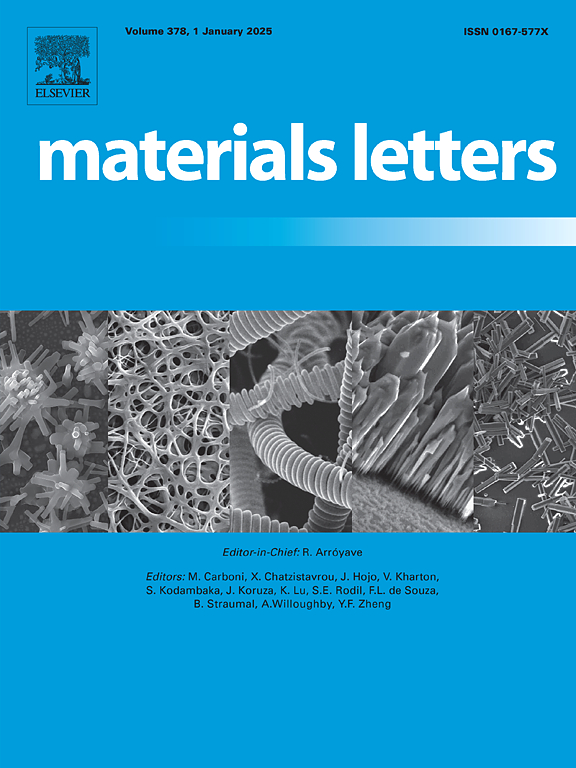Recognition of light sensing p-n junction for hetero-structure CuInSe2/TiO2 and CuInSe2/HF-TiO2: Study of carrier transport mechanism
IF 2.7
4区 材料科学
Q3 MATERIALS SCIENCE, MULTIDISCIPLINARY
引用次数: 0
Abstract
Searching of electronic system with functionality is the epitome of the material research and in this context; nanomaterials CuInSe2 and TiO2 are the promising stars whose possible applications in electronic devices are just endless. However, the fabrication of junction based device using these two materials is most tantalizing prospect in material science is still at its rudimentary stage. In this letter, we report our recognition of current rectification behavior of CuInSe2/TiO2 heterojunction, identical to the I-V characteristics of p-n junction diode and the impact of white light on it. The HOMO-LUMO band positions of hydrothermally derived CuInSe2 and TiO2 nanomaterials indicate that in thermal equilibrium a built-in-potential must arise across the junction. The current-rectification ratio of the configuration Al/CuInSe2/TiO2/ITO is improved from 560 to 627 at voltage ±2 V on white light illumination and this kind of behavior is certainly offering us an unprecedented way to realize the CuInSe2/TiO2 hetero-junction as photo-sensing p-n diode. The device performance is improved further by replacing TiO2 with HF treated TiO2.
识别异质结构 CuInSe2/TiO2 和 CuInSe2/HF-TiO2 的光感应 p-n 结:载流子传输机制研究
寻找具有功能性的电子系统是材料研究的缩影,在这方面,纳米材料铜铟硒(CuInSe2)和二氧化钛(TiO2)是前途无量的新星,它们在电子设备中的应用可能是无穷无尽的。然而,利用这两种材料制造基于结的器件是材料科学中最诱人的前景,目前仍处于初级阶段。在这封信中,我们报告了我们对 CuInSe2/TiO2 异质结的电流整流行为(与 p-n 结二极管的 I-V 特性相同)以及白光对其影响的认识。水热法制备的 CuInSe2 和 TiO2 纳米材料的 HOMO-LUMO 带位置表明,在热平衡状态下,结间一定会产生内置电位。在白光照明下,Al/CuInSe2/TiO2/ITO 配置在电压 ±2 V 时的电流整流比从 560 提高到 627,这种行为无疑为我们提供了一种前所未有的方法来实现作为光感 p-n 二极管的 CuInSe2/TiO2 异质结。通过用高频处理过的 TiO2 替代 TiO2,器件的性能得到了进一步提高。
本文章由计算机程序翻译,如有差异,请以英文原文为准。
求助全文
约1分钟内获得全文
求助全文
来源期刊

Materials Letters
工程技术-材料科学:综合
CiteScore
5.60
自引率
3.30%
发文量
1948
审稿时长
50 days
期刊介绍:
Materials Letters has an open access mirror journal Materials Letters: X, sharing the same aims and scope, editorial team, submission system and rigorous peer review.
Materials Letters is dedicated to publishing novel, cutting edge reports of broad interest to the materials community. The journal provides a forum for materials scientists and engineers, physicists, and chemists to rapidly communicate on the most important topics in the field of materials.
Contributions include, but are not limited to, a variety of topics such as:
• Materials - Metals and alloys, amorphous solids, ceramics, composites, polymers, semiconductors
• Applications - Structural, opto-electronic, magnetic, medical, MEMS, sensors, smart
• Characterization - Analytical, microscopy, scanning probes, nanoscopic, optical, electrical, magnetic, acoustic, spectroscopic, diffraction
• Novel Materials - Micro and nanostructures (nanowires, nanotubes, nanoparticles), nanocomposites, thin films, superlattices, quantum dots.
• Processing - Crystal growth, thin film processing, sol-gel processing, mechanical processing, assembly, nanocrystalline processing.
• Properties - Mechanical, magnetic, optical, electrical, ferroelectric, thermal, interfacial, transport, thermodynamic
• Synthesis - Quenching, solid state, solidification, solution synthesis, vapor deposition, high pressure, explosive
 求助内容:
求助内容: 应助结果提醒方式:
应助结果提醒方式:


